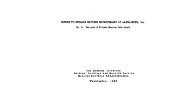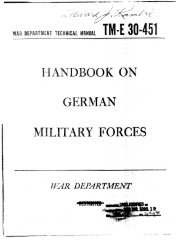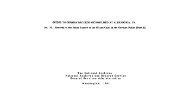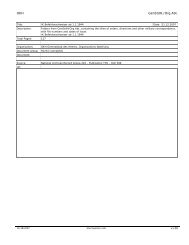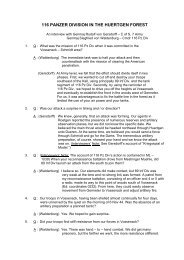miRS-tonpon - Sturmpanzer.com
miRS-tonpon - Sturmpanzer.com
miRS-tonpon - Sturmpanzer.com
Create successful ePaper yourself
Turn your PDF publications into a flip-book with our unique Google optimized e-Paper software.
it should be pointed out that there were practically no OBLs inRussia and consequently no stabilised administrative HQ. CapturedRussian officers with engineering experience provided they wereideologically tractable were retained for their technical knowledge,their knowledge of Russian and their ability to handleRussian workers. Manpower was obtained simply "try stoppingconvoys of Russian prisoners of war on their way to rear and byputting them to work until relieved by the next convoy ofprisoners (This practice of impressing manpower was used not onlyby the OT but also Xy the Army engineers).Simplification and standardisation of building materials andof methods of construction have been intensified to a still higherdegree inside Germany at the present time. Any attempt atuniformity in the productive capacity of "basic" operationalsectors, such as the OBL, has, however, been definitely abandonedin the face of OT's present tasks, seventy percent of which areestimated to be of an emergency nature. For a survey of OT'spresent operational methods within the Reich, see IB16 to 18,20 and IIA32 to 39.For specific aspects of OT methods of operation, see thesection and sub-sections on Supplies (IIFa), Transport (iIFb),Construction Personnel (LLIBb), Chain of Command (IIB),Specifications (IICc), Liaison (IIG), Firms and Contracts (IH)).c) Construction Specifications.51* Standardisation of assembly parts.Standardisation - always dear to the Germans and carriedalmost to the level of a religion by the Nazis - is the keynoteof all OT construction work. The OTZ worked out certain definitespecifications for each assembly unit of a large constructionproject, (pill-boxes, shelters, gun-emplacements, and. so forth}and then allowed the individual Einsatzgruppen extreme latitudeas to how many of these standardised and partly pre-fabricatedconstruction parts were to be used and exactly where. This factaccounts for the uniformity in types of construction in, thoughnot necessarily in the disposition of, the defences on theWestwall, the Atlantic Wall, the Gothic Line and those of the east.As terrain, however, played such a large part in the Germandefensive programme, the OTZ (now Amt Bau/OTZ) wisely allowed theindividual Einsatzgruppen to execute independently special plans,"Sonderzeichungen" which were submitted to the OTZ only forratification. Thus, for instance, one particular type ofemplacement which was especially designed to meet the defensiveproblems imposed by the African terrain became known as a'Tobrukstand'. However, once the 'Tobrukstand' had been foundpractical, it was standardised and used again and again in sandyterrain. Similarly, when France fell and a great many tanks withdamaged bogie wheels and treads were captured, it occurred to theengineers working on plans for the Atlantic Wall to simply imbedthese tanks in concrete, leaving only the turret above the ground,thus providing a practical and economical emplacement with tankturret. This original form of 'pill-box' was subsequentlyircorporated into the standardised list of emplacements.This standardisation was, of course,'practical insofar as itallowed the OTZ to make a pretty accurate estimate of how muchbuilding material should be allotted to each project. For example:1 Type A emplacement needs so and so much Type B concrete(mixture also prescribed: 400 kilos or 8 sacks per cubic metre,added to 70$ sand, 3Qfo gravel, admixture 13^ water).- 51




